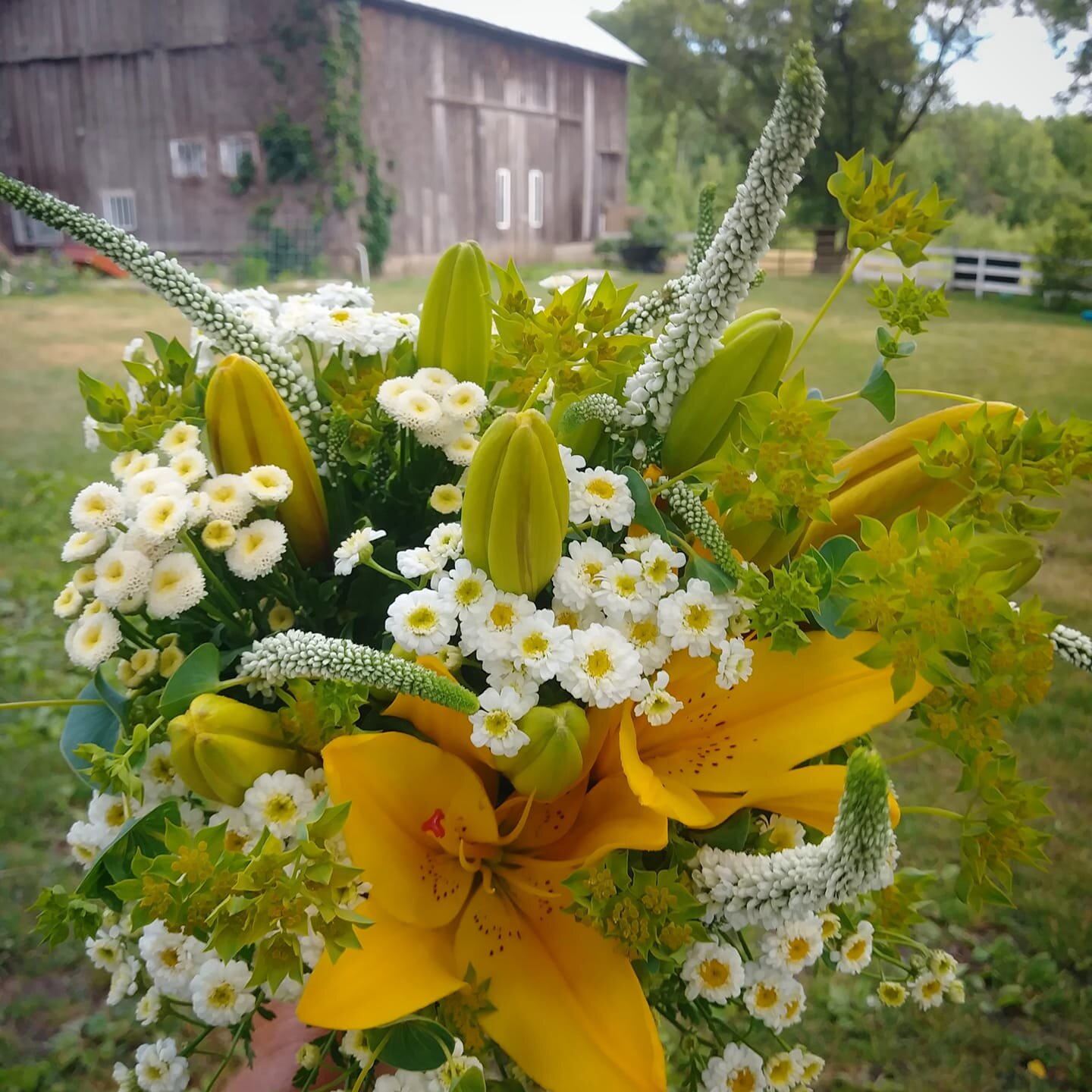Top Tips for Longer Lasting Flowers
Top Tips for Longer Lasting Flowers
When people visit our farm, they often ask “How do I make these flowers last the longest?”
I can’t wait to share some great tips with you, but first… let’s talk about expectations.
With proper care and cutting techniques, flowers can be be expected to last anywhere from 3-21 days in a vase. Yup, I know that’s a HUGE range!
In the flower farming world, we use the term “vase life” to describe how long a flower should last. Vase life differs for EVERY. SINGLE. TYPE. OF. FLOWER (and even amongst one type of flower, different varieties might last longer than others).
For example, a Dahlia typically has a vase life of 3-5 days, while I’ve had Snapdragons, Feverfew and Lisianthus that still look acceptable after 21 days.
5-7 days is considered a “good vase life”, so if you notice flowers beginning to decline after 5 days, this is totally normal.
Now that we have realistic expectations, here are some helpful techniques to tip the odds in your favor and make those blooms last as long as possible!
1. Cut Early or Late in the Day
I know it sounds dreamy to wander around in a field of flowers on a bright sunny summer afternoon, cutting a bouquet... but don't.
JUST DON'T. A hot sunny afternoon is pretty much the worst time to cut flowers, so avoid it as much as possible! Flowers cut in the heat of the day expire MUCH FASTER than those cut in the cool parts of the day.
Dawn and dusk are the best times to cut, preferably before the sun is up or after it has set.
If you are having problems with a certain flower wilting immediately and never recovering, or flowers that don't last long, I would suspect you are not cutting at the correct time of day.
Certain flowers/foliage need to be cut earlier than others. For example, if I try to cut Lemon Basil after the sun has risen over the horizon, it will immediately wilt. I know I need to get out there early and cut before sunrise. You will need to do some trial and error to figure out what works!
Moral of the Story: Get your buns out of bed before the sun is up. ;) It's truly the VERY best way to start your day and the flowers will thank you with days of beautiful blooms!
2. Keep It Clean
Cleanliness is VITAL. Bacteria is often what causes cut flowers to wilt and wither prematurely.
Your clippers/scissors/shears should be clean and sharp. Wash or wipe down your clippers with rubbing alcohol periodically, ideally before every cutting session.
Your buckets and vases also need to be sparkling clean. No nasty gunk or dust or dirt.
If you wouldn't drink out of it, then it's not clean enough! This is not a joke.
Yup, I’m going to say it again. Your bucket MUST be clean enough to drink out of. Trust me. It makes a big difference (and yes, we spend a TON of time scrubbing buckets in hot soapy water and yes, I would drink out of them. Ha!).
If you put those freshly cut stems into dirty water in a dirty bucket, you’ve pretty much guaranteed the stems are going to get clogged up with gunk and expire way faster.
KEEP YOUR BUCKETS AND CLIPPERS IMMACULATE. Got it? ;)
3. Cut at the Correct Stage
“Stage of cutting” refers to how open the flower should be at harvest time.
Should it be fully open? Barely open? Halfway open?
Lots of people are cutting flowers way too late (too open) and naturally, not getting the longest vase life.
Unfortunately, there is no “one-size-fits-all” rule for the ideal stage of cutting. It varies with EVERY. SINGLE. TYPE of flower. Again, there is going to be some trial and error here!
With some flowers, such as Poppies, Sunflowers and Cosmos, you want to cut them right when they are beginning to open/bloom, in order to have the longest vase life. Cut these flowers earlier than you think and enjoy watching the flowers open up in the vase!
On the opposite spectrum, Dahlias and Zinnias don’t open much after being cut, so they must be allowed to bloom fully on the plant before being cut.
Most flowers are somewhere in between. Foxglove, Snapdragons and Delphinium, for example, are best harvested when the bottom 2-3 blooms on the stem have opened up.
For some flowers, especially Zinnias and Black-Eyed Susans, it's helpful to perform "The Wiggle Test". Grasp the stem about 8" below the flower and wiggle it. If the flower flops around, it's not ready to be cut. If the stem remains firm, cut away!
4. Make Deep Cuts and Remove Foliage
When you are out in the field, be sure to make "deep cuts" - that is, cut your stems at least 12"-18”.
Elbow to fingertip length is perfect. You can always cut them shorter later!
Cutting deeply will actually signal the plant to produce even MORE long stems, so don't be shy about cutting deeper than you think. As long as you leave 2-3 sets of leaves near the base of the plant, you should be good!
Immediately after cutting, gently strip or cut off all the foliage from the bottom 2/3 of the stem. Leaves/foliage will muck up the water quickly, so get rid of any leaves that will touch water.
I repeat - NEVER, EVER allow leaves/foliage in the water!
5. Hydrate Properly
After cutting and stripping off the foliage, immediately place the stems in cool, CLEAN water in a CLEAN bucket or vase.
It's best to cut stems at an angle, so they don't sit flush with the bottom of the bucket. An angled cut also creates a larger surface area for the stem to draw up water.
If possible, it's best to allow the flowers to rest in a cool place out of the sun for a few hours (or overnight) before arranging. Some flowers need a few hours to "re-hydrate" and perk up. They just went through a lot of stress, so give them some time to literally “chill out”.
(If you find the water in your bucket is dirty after harvesting your flowers, I recommend transferring the flowers to a new clean bucket with clean water when it’s time for them to rest and rehydrate.)
Give those flowers plenty of time to rest before trying to arrange them into bouquets. Here’s a sample cutting schedule if I need some arrangements for a Friday evening:
Thursday - cut in the evening
Thursday overnight - allow flowers to rest and rehydrate in CLEAN water in a cool location
Friday morning - arrange flowers and store in a cool location until event time
Friday evening - display flowers
6. Avoid Sun and Heat
After you’ve arranged your flowers and want to display them, DO NOT set your bouquet in direct sun. While sun is necessary for flowers to grow, once they are cut, they need to be kept AWAY from the sun. A windowsill might not be the best location!
Heat also causes flowers to expire more quickly, so be aware that a bouquet picked and displayed in the heat of the summer will not last as long as a spring or fall bouquet... unless you keep your house very cold with air conditioning!
7. Keep Flowers Away from Fruit
Ripening fruit, like bananas, apples, avocados, peaches and pears, produce ethylene gas, which causes flowers to expire and wilt prematurely. If you have fresh fruit on your kitchen counters, the kitchen is not a great place to display your flowers.
Some flowers, like Sweet Peas and Dahlias, are particularly sensitive and can expire nearly overnight if subjected to ethylene gas.
8. Change Water Daily and Re-cut Stems
Fresh, clean water and a sparkling clean vase will significantly extend the life of your bouquet. Dirty water breeds bacteria and clogs the stem end of the flower, reducing water intake.
Again, make sure there are no leaves/foliage in the water!
Re-cutting the stems every few days will also allow the flowers to keep "drinking" properly.
There are a few types of flowers that make the water murky almost immediately. If any of these are in your arrangement, you’ll likely need to change the water every single day and possibly even add a drop of bleach to the water. Just a drop! Not a teaspoon. Ask me how I know this ;)
Flowers that muck up water:
-Zinnias, Black-Eyed Susans, Yarrow, Stock, Ornamental Kale/Cabbage, Oregano
9. Choose Water Wisely
Depending on where you live and what type of water you have, it might be helpful to use filtered water for your bouquets.
If you have softened well water, the salts in the water could cause your flowers to expire faster. Try filtered water instead. I don’t have scientific evidence to prove this, but I’ve noticed my bouquets in softened water don’t last as long.
10. Use Flower Food
Search the internet and you will find about a bazillion different “Awesome hacks!” for keeping your flowers fresh. Some work, some don't. Take everything with a grain of salt or do like I do… just skip this part ;)
Yup, I hardly ever use flower food. But if you want to, I recommend a commercial flower food like FloraLife, because it contains:
Sugar (to feed the flowers)
Acid (to maintain correct pH)
Bleach (to kill bacteria)
Soda (like Sprite) comes in a close second to flower food. The sugar and acid in the soda mimic the effects of flower food. Choose a clear soda to keep the water looking clean. Add a few tablespoons each time you change the water.
There you have it! With these tips and techniques, you’ll be equipped to get the best and longest vase life out of your flowers!
Now get out there and go cut some blooms!
-Lori


